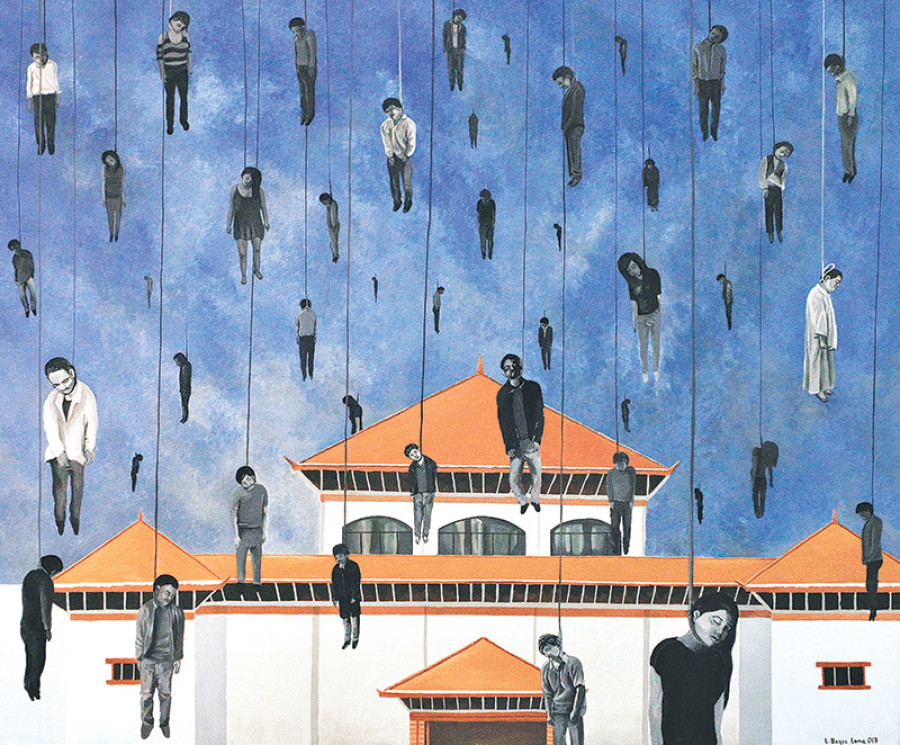Entertainment
Cutting across cultures and histories
The eighth National Fine Arts Exhibition is currently being held at the Nepal Art Council in the Capital. The exhibit spans three floors of the venue and includes paintings, sculptures and mixed media works by numerous Nepali artists. Wednesday, April 18, was the opening day of the show. The inaugural day also saw the awarding of ‘Best Painting’ prizes to artists from each of the federal provinces, as well as awards for regional, provincial, and for ‘special categories’.
Rahul Dhakal
The eighth National Fine Arts Exhibition is currently being held at the Nepal Art Council in the Capital. The exhibit spans three floors of the venue and includes paintings, sculptures and mixed media works by numerous Nepali artists. Wednesday, April 18, was the opening day of the show. The inaugural day also saw the awarding of ‘Best Painting’ prizes to artists from each of the federal provinces, as well as awards for regional, provincial, and for ‘special categories’.
Basun Rai’s painting of his grandma was one of the works that won in the special category. The painting is well executed and very beautiful. Rai is a technically gifted painter and the painting, Hajur Ama, is rendered with coruscating brush work that run along and against each other, a kind of reticulated speech cast like a net over the moment and memorialised in paint. Rather than describing the local colours of the space and subject, Rai tries and succeeds in palpably capturing their reaction to light with his palette serving as sort of analogy to reality. With parts densely shadowed and parts elusively shaded, part softly illuminated and part fiercely lit, the painting plays with the contradictions of light and as such shows how things exist in the world—more importantly perhaps, it shows how his grandma existed in that moment and in a way always will.

Art history references litter this exhibit with many remarkable works riffing on concepts that date back to some of the earliest works of art known to history. Laya Mainali’s bronze sculpture, Torso 2, is reminiscent in form and execution of the Venus of Willendorf, a female figurine estimated to have been made between 28,000 and 25,000 BCE. The torso is definitely a voluptuous one with smooth rhythmic contours. There are no identifiable features in the sculpture aside from the torso and the undulating hips underneath and as such, it feels kind of like a fever dream and a fertility talisman, much like the prehistoric figurine it probably refers to.
Ramesh Kadayat’s sculpture of a sunflower made out of mechanical parts was another work that was awarded under the special category and another work that takes a longstanding art history motif for its subject. Vincent van Gogh’s paintings of Sunflowers are somewhat famous but less known is the fact that his choice of subject and distinct aesthetics were drawn from older Japanese Ukiyo-e prints that were popular in Europe at the time. And now by way of a convoluted route across time and internet, Kadayat has rendered a sunflower out of mechanical parts—his medium speaks to his time and place but his subject is dated and instills in the work a sense of continuity of tradition—one wrought from motifs and references that cut across cultures and histories.

Uttam Dangol’s untitled sculpture of embracing forms is aesthetically similar to the works of Romanian modernist sculptor Constantin Brâncusi, while Bishnu Prasad Shrestha’s sculpture of a woman, Memory 2, with its elongated neck and narrow shoulders, is reminiscent of the style of modernist painter/sculptor, Amedeo Modigliani, whose works themselves drew from the Bronze Age, Minoan sculptures among other sources. It’s a long and convoluted trajectory of things that brings people into existence and brings into being anything that people do. Art is testament to this and the works at the NAC are no different.
The exhibition is slated to run until April 29.




 7.12°C Kathmandu
7.12°C Kathmandu










